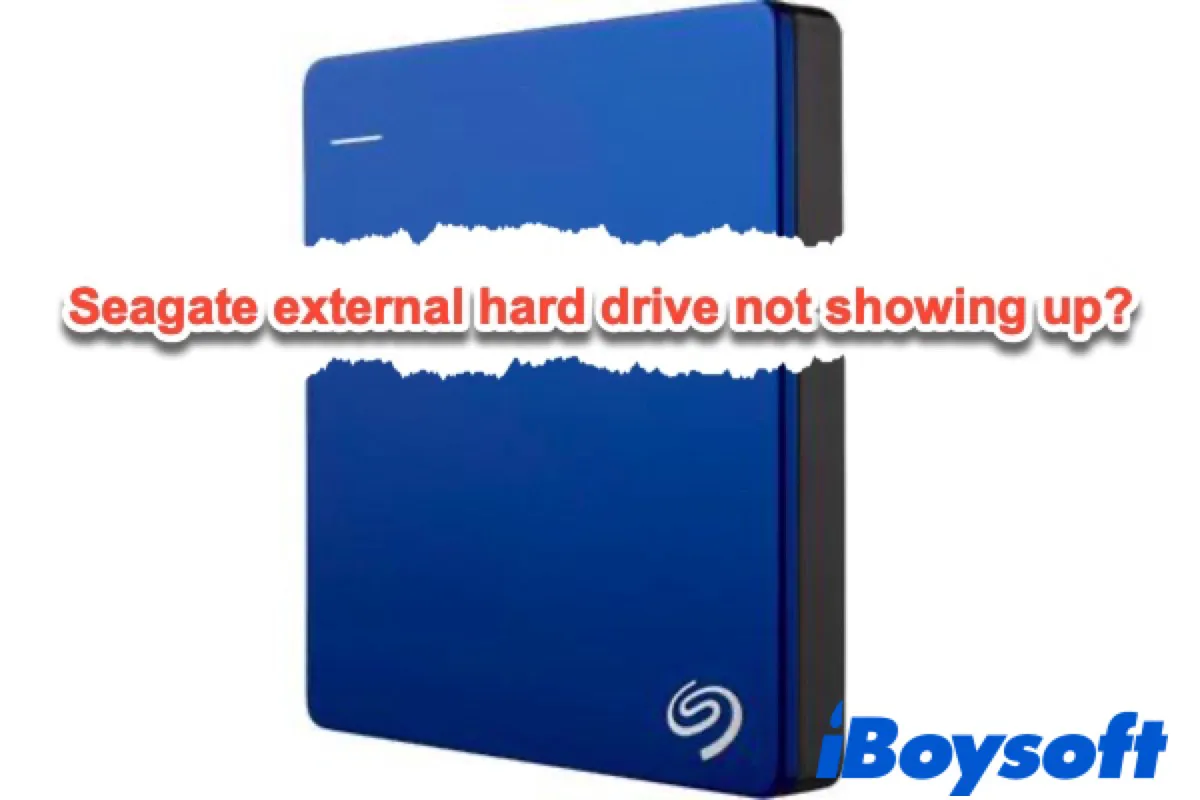It's frustrating to see your Seagate external hard drive not showing up on Mac when you need to open it for file access. This may happen on Mac when plugging in a new drive, after updating to macOS Sequoia or another operating system, or even when you were just working with it as usual.
Many users may mistake a drive not showing up on the desktop or in Finder as the drive is not recognized on Mac. The easiest way to find out the real case is to check if the Seagate external hard drive shows up in iBoysoft Data Recovery for Mac.
If it's detected by the data recovery software, it must also be recognized by your Mac. In this case, you can recover data from the malfunctioning drive and reformat it to resolve the problem efficiently. However, if you want to dig deeper, keep reading!
If it's not showing up in the software, your Seagate hard disk is not detected on Mac and you need to make your Mac recognize it first.
To help you navigate to different scenarios of "Seagate not showing up on Mac," we divided the issue into three categories based on whether the Seagate hard drive is listed on the left sidebar of Disk Utility and is accessible.
- The Seagate external hard drive is detected and accessible. (Appears in Disk Utility; can access the drive by right-clicking and choosing "Show in Finder.")
- The Seagate external hard drive is detected but not accessible. (Appears in Disk Utility but is grayed out.)
- The Seagate external hard drive is not detected in Disk Utility (macOS Sequoia bugs). (Doesn't appear in Disk Utility.)
Fortunately, Seagate external hard drive problems like Seagate Backup Plus drive not showing up on Mac are fixable.
Reddit discussions on Seagate not showing up on Mac
A few users have posted on Reddit regarding the issue of their Seagate hard drive not showing up on Mac. Some had experienced it with a brand-new Seagate external HDD (as shown in the thread below) or a new MacBook. Others encountered it on acquainted devices and found their Seagate hard drive light on but not detected on Mac.
Brand new Seagate external HDD not showing up.
by u/sweetrouge in MacOS
No matter what the scenario is, you should find the reasons and solutions in the coming paragraphs.
Recover data from the unrecognized Seagate external hard drive
When your Seagate external hard drive is not working on Mac, including not being recognized or being recognized but not accessible, you need to perform a Seagate hard drive data recovery to avoid losing crucial data.
iBoysoft Data Recovery for Mac can recover data from unrecognized Seagate Backup Plus drives and unreadable Seagate external hard drives.
Moreover, this Seagate external hard drive data recovery software also supports:
- File recovery from hard drives of Seagate, WD, Toshiba, Samsung, etc.
- Recovering lost data from formatted, unmountable, inaccessible, unreadable, or corrupted hard drives.
- Recovering lost data from Macintosh HD drives, USB flash drives, SD cards, memory cards, etc.
- Mac OS X 10.11 and later version.
- Apple T2 chip, M3 chip, M2 chip, M1 chip, M1 Pro chip, M1 Max chip, Intel chip.
How to recover data when Seagate external hard drive is not working on Mac:
- Free download, install, and launch iBoysoft Data Recovery software on your Mac. For your information, first-time installation of this program requires you to allow Full Disk Access and enable system extensions on Mac.
- Make sure your inaccessible Seagate external hard drive is connected to your Mac.
- Select the Seagate external hard drive and click the "Search for Lost Data" button to scan for all the lost files and folders.

- While scanning for lost files, you can either pause or stop the scan process anytime, and then start recovering. But for the best recovery results, you'd better wait until the whole scan process is over so that you can recover most of the missing or lost files from your external hard drive.
- When the scan process is finished, select the files you want to recover, and click the Preview button to check if the selected file is corrupted. You can sort wanted files by type, created date, name, and other parameters, it's all up to you.
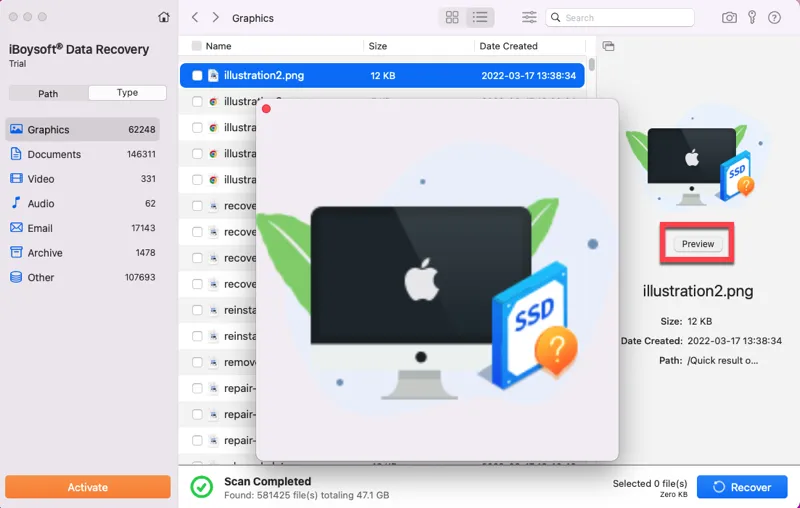
- Select the files you need by ticking the checkboxes next to them, and click the Recover button to recover data from the unrecognized Seagate external hard drive. This software will automatically save the recovered files to the internal disk of your Mac, just remember not to save them to the same unrecognized Seagate hard drive you scanned.

After getting essential files off the Seagate hard drive, let's look at why your Seagate external hard drive is not showing up on Mac and how we can fix it.
Why is my Seagate hard drive not showing up or working on Mac?
A lot of Mac users who can't see the external hard drive on Mac had a similar experience of seeing the Seagate hard drive light on but not detected on Mac like this one:
"I have a MacBook Pro with macOS El Capitan. My WD hard drives are recognized, but my new Seagate 1T drive is not showing up. The light on the drive works, which tells me that it is drawing power from the computer. But the computer does not recognize the drive. Anyone knows how to fix Seagate external hard drive not recognized, showing up, or detected on Mac or at least recover files from the drive?"
Unable to see the Seagate hard drive is one of the most common external hard drive problems people reported, with various causes. Here are some of the frequent ones:
- Bad USB port
- System failure
- File system corruption
- Motherboard issue
- Virus infection
- macOS updating issues
- External drive damage or corruption, etc.
Now we should understand the reasons behind the "Seagate external hard drive not showing up on Mac" problem. Follow the solutions below to get it fixed so that you can open the Seagate external hard drive on Mac as you want.
How to fix Seagate external hard drive not showing up or working on Mac?
Scenario 1: The Seagate external hard drive is detected and accessible in Disk Utility.
We all expect a drive to appear on the desktop or in Finder and Disk Utility right after it is connected to Mac, and it is supposed to do so. However, if this is the first time you use the Seagate hard drive on Mac, it's best to check the settings to avoid your Mac not displaying external hard drives in Finder and on the desktop.
How to open Seagate's external hard drive in Finder & on the desktop:
- Click Finder, tap on Finder in the top-left menu bar, and choose Preferences.
- Under the Sidebar tab, select "External disks" under "Locations", and then your Seagate external hard drive will show up in Finder.
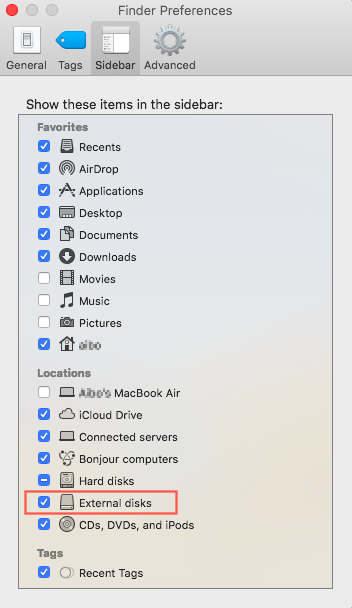
- Click the General tab, and tick "External disks" to show the Seagate external hard drive on the desktop.
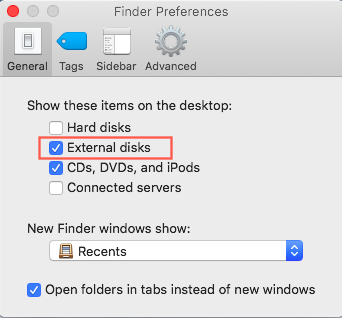
After changing the setting, you will likely see the Seagate external hard drives showing up on the desktop and in Finder.
This seems easy to fix, but what if the Seagate external hard drive is not working though being recognized in Disk Utility?
Scenario 2: Seagate external hard drive is detected but not accessible in Disk Utility.
On some occasions, the Seagate external hard drive is detected as it shows up in Disk Utility but needs to be mounted to enable your Mac operating system to read and write files to it.
In Disk Utility, select View > Show All Devices to view the volumes under the Seagate external hard drive. You may find the partition under the drive grayed out in Disk Utility, which means Mac cannot mount the external hard drive.
So the question pops up: how to use Seagate external hard drive on Mac when Mac can't mount it? Follow the solutions below.
Solution 1: Manually mount the Seagate external hard drive
You can simply right-click this external hard drive in Disk Utility and choose Mount or click the Mount button on the top of the window to mount the Seagate external hard drive for Mac.
If it can be mounted, it'll show up on your desktop and allow you to access files. If not, follow solution 2 to repair it.
Solution 2: Repair the Seagate external hard drive with First Aid
If you can't manually mount the Seagate drive, it may be due to disk errors preventing your Mac from correctly recognizing or detecting the drive. Fortunately, there is a native disk repair tool called Disk Utility on your Mac, and you can repair your external hard drive with the following steps.
- Connect the Seagate hard drive to your Mac.
- Click on the Launchpad on the Dock and find Other.
- Locate Disk Utility and open it.
- Select the unmountable external hard drive in the left sidebar and choose First Aid at the top.
- Click Run to repair this Seagate hard drive.
After First Aid finishes, check whether the Seagate drive is mounted. If not, move on to solution 3.
Solution 3: Fix the unmountable Seagate external hard drive by reformatting.
If First Aid fails to repair this drive, the file system or the partition table of this external hard disk could be corrupted. In this case, reformatting is a feasible method to set up a new working file system or partition table for the drive.
Please be reminded that reformatting a drive will erase all data on it. Therefore, if you don't have a backup of important files on the drive already, you can recover files from the Seagate hard drive with Seagate HDD data recovery software to avoid data loss.
After saving files to another working hard drive, you can now reformat the external hard drive on Mac.
That will be another story if your Seagate external hard drive is not showing up in Disk Utility. We will cover six ways to fix the Seagate hard disk not detected in Mac in the next part.
Scenario 3: Seagate external hard disk is not detected in Disk Utility.
You may see the Seagate hard drive light on but not detected in Disk Utility, mainly caused by hardware problems. Before spending hundreds of dollars on repairing, follow the solutions below to troubleshoot the Seagate external hard drive.
The very first thing to do is check whether the drive is properly plugged in. Try to plug in the drive slowly to offer extra time to initialize and connect better.
Solution 1: Check the cable, port, and connector
The Seagate external hard drive beeping and not being recognized on Mac could be a result of a damaged cable or the cable not supplying enough power. Try using another cable, an external power source, or a self-powered USB hub to connect your Seagate drive to your Mac. Also, try different ports on the Mac.
If the cable and port are all good, but the "Seagate external hard drive not working on Mac" issue still exists, follow solution 2.
Solution 2: Use another device
Mac won't recognize the Seagate external hard drive when the drive itself is damaged or corrupted. You can test it on another computer, Mac or Windows PC, to see if it can be recognized. If the drive is inaccessible in another Mac, then it's the drive to blame. You can replace it with a new one or seek help from the manufacturer or a repair shop.
If it only works on a Windows PC, it's likely not formatted to be used on macOS. You can back up data on the drive, then reformat the Seagate drive to exFAT to work with Windows and macOS. Or download an NTFS for Mac driver to open the Seagate drive without reformatting.
If your hard drive works on another Mac that hasn't updated to macOS Sequoia as yours, you need to handle some macOS bugs to get the drive working again.
Solution 3: Solve macOS Sequoia bugs
Several posts on Apple Forums and Reddit have complained about G-drive or Seagate hard disk not being detected on Mac after updating to macOS Sequoia. There is likely a bug causing macOS Sequoia to stop supporting certain USB hubs. A proven solution is to replace your cable with an Apple-manufactured USB-C to USB-C cable, preferring one with higher data transmission speed.
Suppose you don't have USB-C ports on your Mac or the Seagate drive. You can downgrade macOS Sequoia to the one you used before with a Time Machine backup or a bootable installer.
If the solutions mentioned before are of no avail, sometimes a simple reboot can fix the problem.
Solution 4: Reboot your Mac
Rebooting your Mac clears your Mac's memory, and starts fresh; hopefully, that will reset things to normal. Unplug all peripherals connected to your Mac, click the Apple logo > Shut down to power off the Mac, then press the power button to turn it on. Now try plugging your Seagate drive into the Mac again to see if the Mac detects it.
If this doesn't help, try to reset NVRAM to reset hard drive information stored on your Mac that may stop the Seagate drive from being recognized.
Solution 5: Reset the NVRAM
- Click the Apple logo > Restart to restart your Mac.
- Hold down Option + Command + P + R simultaneously once the screen turns black.
- Continue pressing the four keys until you hear the startup chime twice or the Apple logo appears and disappears for the second time.
- Go to Disk Utility and check if your drive appears.
If resetting the NVRAM is unsuccessful, the last thing we can try is to boot into Safe Mode to see if there is third-party software preventing your drive from being detected on Mac.
Solution 6: Boot into Safe Mode
By booting into Mac Safe Mode, you can determine whether there is software resulting in your Seagate external hard drive not working on Mac. If your Seagate external hard drive is revealed in Safe Mode, you can uninstall recently-download apps and restart your Mac again to check whether your drive is recognized on Mac.
These are the solutions to try when Seagate won't show up on Mac. If you consider them helpful, share this post!
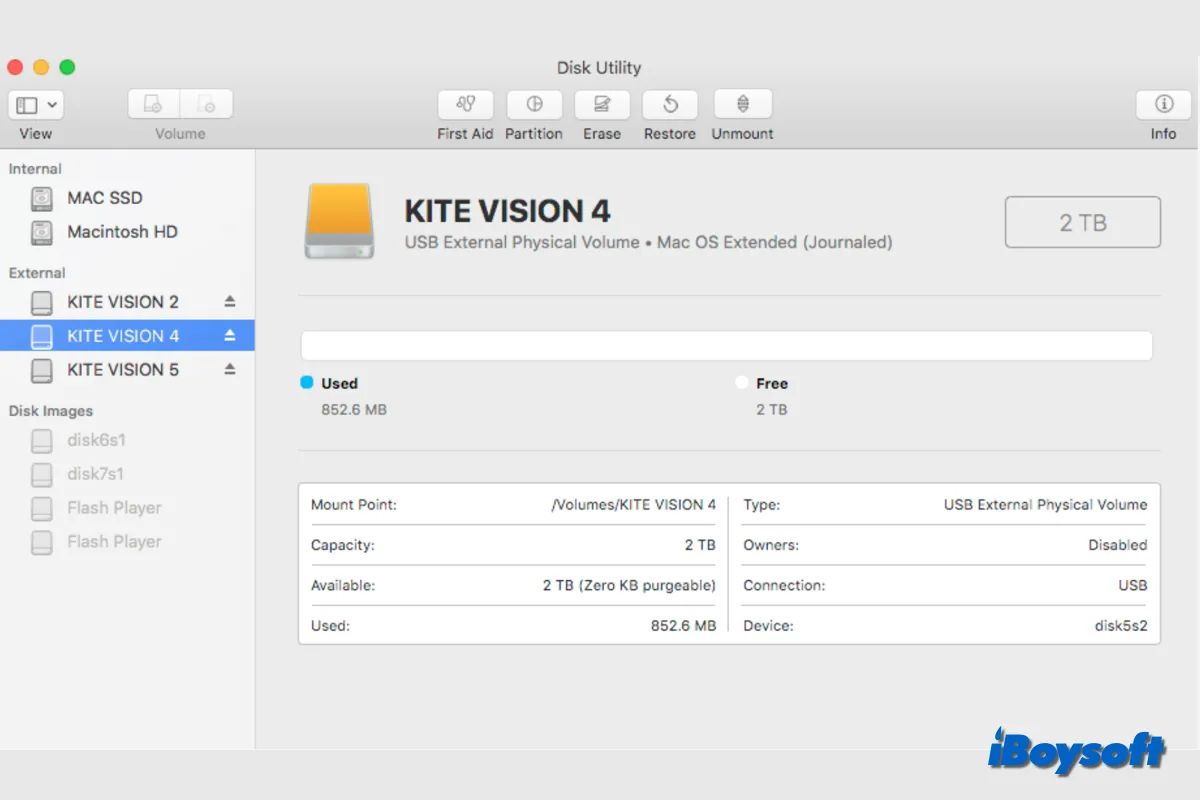
It is abnormal if the external hard drive shows up twice on your Mac. This post explains the reasons and provides possible solutions to fix duplicate external hard drives in Mac Finder. Recover data with iBoysoft Data Recovery for Mac if any file is lost on the duplicate external drive.
Conclusion
If you have successfully fixed the drive, you can now use the Seagate external hard drive on Mac as you like. But the final suggestion we want to offer is to safely eject your external hard drive whenever you are done using it. To do this, you can right-click on the hard drive icon on your desktop and select Eject.
If unfortunately, Mac still won't recognize your Seagate external hard drive, you can consult Seagate support or hard drive repair service to get it fixed or buy a new one.
